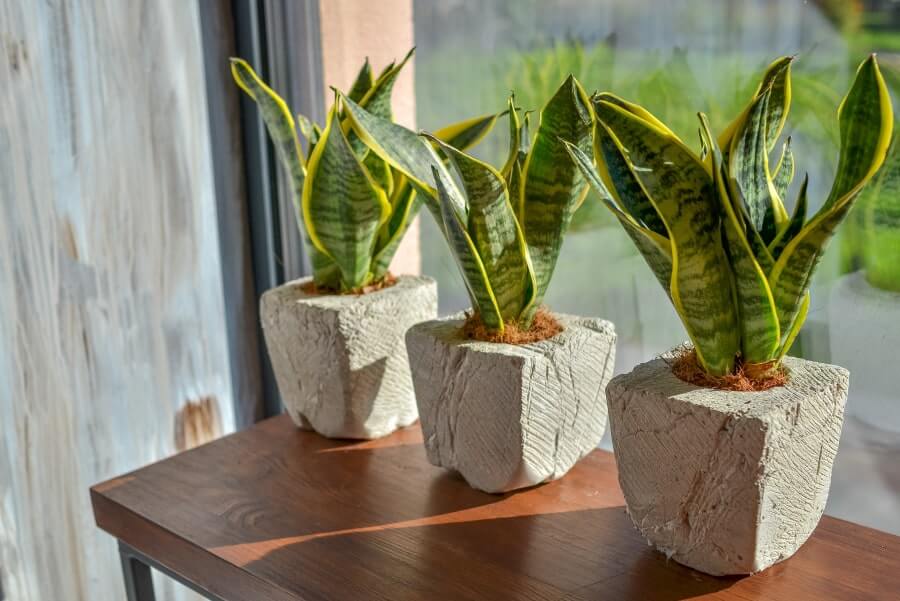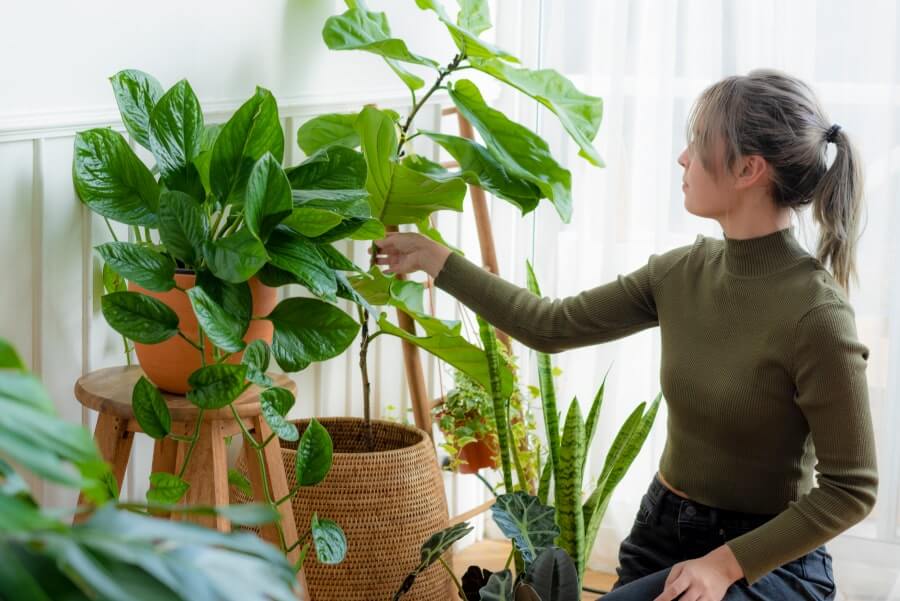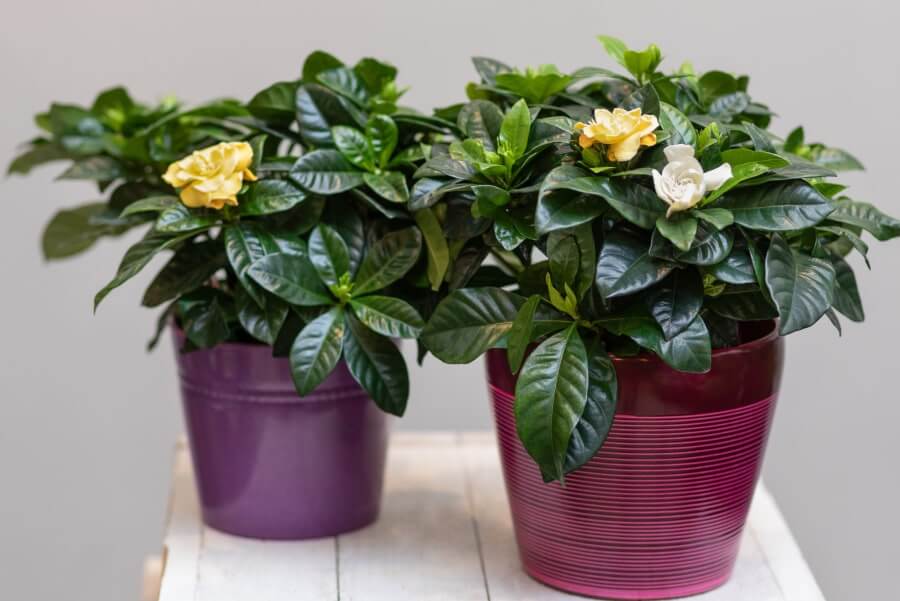Did you know that adding plants to your bedroom can have some serious benefits? Not only do they boost the room’s aesthetic, but they can also help improve air quality, provide detoxification support, and even promote better sleep.
If you’re looking for the best plants to add to your bedroom, check out our list below. We’ve included ten of our favorites, all of which are perfect for any homeowner. So what are you waiting for? Start incorporating these plants into your bedroom today!

10 of the Best Plants for the Bedroom
Bedroom plants are not only good for your health, but they also add a nice touch of decor and a burst of energy to any room. Keeping a few smaller plants in your bedroom will add some greenery to your space. Which houseplants are the best for your bedroom?
Snake Plant –
Also known as “Mother-In-Law’s tongue,” this low-maintenance plant is perfect for the bedroom. The plant also converts carbon dioxide into oxygen at night (something most other houseplants do only during the day).
Heart Leaf Philodendron –
Philodendrons are popular houseplants because they are almost impossible to kill. Their heart-shaped leaves have a variety of visually appealing variations and serve as extremely effective absorbers of formaldehyde.
English Ivy –
English Ivy has a remarkable ability to absorb formaldehyde, benzene, xylene, and toluene. Research shows that English Ivy removes toxins from the air, but it can also help clear the air of mold and animal feces, which may improve allergy symptoms.
Golden Pothos –
The trailing pothos plant is effective at filtering out formaldehyde, carbon monoxide, and benzene. These plants are extremely easy to care for and grow.
Spider Plant –
This plant is capable of combating pollutants such as benzene, formaldehyde, carbon monoxide, and xylene.
Rubber Plant –
The striking forest green leaves of this plant eliminate toxins and purify the air. It improves indoor air quality by absorbing airborne chemicals.
Gardenia –
These flowers have beautiful, fragrant blossoms that make them a popular bedroom plant. Researchers have found that these plants may help you to sleep better and relieve anxiety.
Peace Lily –
Peace Lilies bloom beautiful white flowers that are perfect for indoors, because they are known to clean the air of formaldehyde, benzene, acetone, alcohols, and trichloroethylene. These plants are poisonous so make sure to place them somewhere that is out of reach for children and pets.
Areca Palm –
Tropical plants like the Areca Palm add a touch of lushness to any indoor space. These are known for their air-purifying properties that remove harmful toxins such as benzene, formaldehyde, and trichloroethylene. It is one of the most effective plants for removing carbon dioxide from the air.
Aloe Vera –
Aloe Vera releases oxygen during the night, which makes it an ideal sleeping aid. This plant is also easy to take care of since it is tolerant of neglect, such that you can go three weeks without watering it and it will still survive. Additionally, these succulent plants have medicinal benefits. The juice from their leaves is applied topically to scrapes and burns to soothe them.

When caring for plants indoors, it’s helpful to remember the following tips:
Recognize when plants need water.
Be more concerned with over-watering than under-watering; plants are usually better off slightly dry than soaked in water. In general, you want to make sure your plants receive enough water to keep the soil moist but not soggy.
Be aware of temperature, humidity, and ventilation.
The best conditions for houseplants are temperatures between 65 and 75°F during the day and about 10 degrees cooler at night. A level of humidity similar to that of their natural environment is generally required for houseplants. Other houseplants can be harmed by long-lasting condensation on leaves, which is why good airflow is essential.
Provide your houseplants with the appropriate amount of light.
Photosynthesis is essential for all plants, but different houseplants require different amounts of light. Most require indirect light rather than direct light, except for desert cacti and other succulents.
Use the right potting soil.
Roots thrive in high-quality potting soil because it provides the ideal balance of nutrition, aeration, and water absorption. Mixtures of peat moss, shredded pine bark, perlite, and vermiculite are common for potted plants.
Select a pot that fits your plant.
Make sure that the pot you choose is made from the proper material, is the right size, and has adequate drainage. Your pot should be proportional to the size of your plant — no more than a couple of inches in diameter wider than its root mass. When the potted plant outgrows its pot, you can transplant it into a larger one. The roots of a plant that is planted in a larger pot than necessary will not be able to absorb moisture fast enough as it drains through the soil.
Use fertilizer to supply nutrients.
To maintain sustained, healthy indoor plant growth, the potting soil should be replenished regularly. As a general rule, fertilize your house plants once each month when they are growing or blooming.
Plants are typically placed in bedrooms for their calming, sleep-inducing effects:
- Jasmine
- Lavender
- Gardenia
- Valerian
- Chamomile
Sleep Issues – How Plants Can Help
Jasmine has a soothing effect on mind and body alike. This pleasant aroma is great for refreshing your room and for helping you get a restful night’s sleep. The aroma of jasmine reduces anxiety, thus increasing your ability to sleep at night and perform well during the day.
Bedroom plants made of lavender often help to foster a relaxing environment and to induce better sleep through the use of essential oil diffusers and sachets tucked under pillows. This plant helps you relax during the day and quickly puts you to sleep in the evening. The smell of lavender reduces stress and crying in babies while helping them sleep.
Like lavender and jasmine, gardenia is often used in bath salts, candles, and other aromatherapy products. Fresh-smelling flowers can reduce stress and promote sleep. According to one study, you are less likely to wake up in the middle of the night and more likely to sleep soundly with these flowers in your bedroom.
A valerian flower aids in falling asleep and staying asleep quickly and easily. If you have trouble sleeping at night and want to infuse some soft color into your bedroom, these blooms are perfect for you.
Chamomile is widely regarded as a mild tranquilizer and sleep-inducer. Consider keeping it close to your bed, perhaps next to a lavender plant, so you can enjoy its scent and the fresh and relaxing aroma all night. You can also use the blooms of your plant to make fresh chamomile tea and oils.








